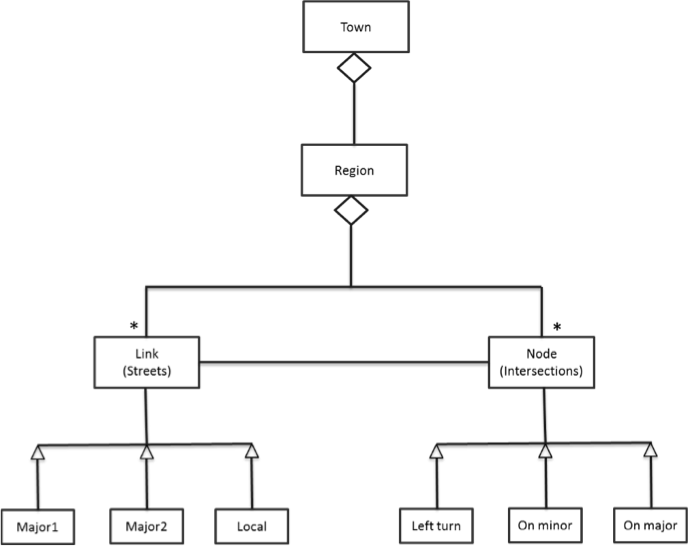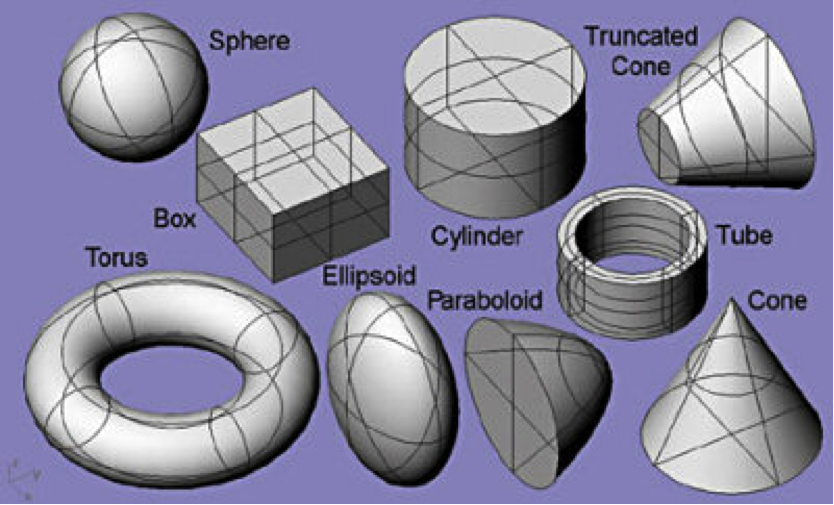
Figure 1. Simple class hierarchy diagram for modeling a town.
 ENCE 688R Projects, Spring Semester, 2016
ENCE 688R Projects, Spring Semester, 2016
[ Project 1 ]:
Framework for Modeling Textual Requirements and Mathematical Constraints
[ Project 2 ]:
Distributed System Behavior Modeling with Ontologies and Rules
[ Project 3 ]:
Macroscopic Traffic Modeling of the I-95 Corridor between Washington DC and Baltimore
[ Project 4 ]:
Simulation of Autonomous Robots in Warehouses
[ Project 5 ]:
Modeling Travel Time on Arterial Networks
[ Project 6 ]:
Job Scheduling Application
[ Project 7 ]:
Three-Dimensional Visualization of Solid Models with JavaFX
Title: Framework for Modeling Textual Requirements and Mathematical Constraints
Authors: Jessica Knizhnik and Ted Zontek-Carney
Abstract: Systems Engineers frequently develop and maintain large numbers of requirements. This project will develop a framework for categorizing and organizing requirements. Requirements will all have the option to include an id, text, a symbolic expression, a verification method, a subsystem, a parent, children, a template type and a discipline type.
This project will develop a method for organizing and querying the requirements to show subsets of the listed categories. For instance, a user could easily find all thermal (discipline type) requirements which are verified by analysis (verification method). This project can then be extended to support varying types of requirements analysis including performing requirements checks and trade studies.
References
Title: Distributed System Behavior Modeling with Ontologies and Rules
Author: Maria Coelho
Abstract: Modern infrastructure systems are becoming increasingly complex and interdependent. Recent natural catastrophes such as Hurricane Katrina (2005) and the Northridge Earthquake (1994) have revealed that multi-level systems are vulnerable to catastrophic cascading failures. Disturbance in one system level can affect other system levels in unpredicted and undesirable ways. Therefore, modeling the interactions among of multi-level engineering systems is critically important yet technically challenging. Existing methods have limited consideration of the failure interdependency caused by these interactions among subsystems.
The objective of this project will be to provide engineers with tools to model system-level interactions and simulate distributed system behaviors through the use of ontologies, rules checking, and message passing mechanisms. As a first step, the model's arrchitecture will be demonstrated through the scenario of families interacting with a school system.
References
Title: Macroscopic Traffic Modeling of the I-95 Corridor between Washington DC and Baltimore
Author: Zachary Bennett Vander Laan
Abstract: Traffic simulation models are often used to understand the impact of policy decisions on user delay, congestion, emissions, and travel time between locations on a transportation network. Macro-level simulation is one approach to modeling, and it treats traffic flow as a fluid, drawing on principles from fluid dynamics to understand the aggregate behavior of traffic along segments of the road over time.
This project will focus on modeling part of the I-95 corridor between Washington DC and Baltimore at a macroscopic level, capturing aggregate measures of density, speed, and volume over time as vehicles enter and exit the corridor. The underlying theory is based on Daganzo's Cell Transmission Model (1) and modeling work by Papageorgiou (2,3).
The software implementation will use JGraphT and Java Collections to represent the network structure and keep track of traffic metrics over time.
References
Title: Simulation of Autonomous Robots in Warehouses
Author: Mike Morency
Abstract: This project expands upon a project from ENSE 621 and 622. The system created in those classes is an autonomous warehouse navigation robot which retrieves ordered items for customers. The system consists of three main components: an ordering kiosk, a number of central hubs or docking stations, and a number of picker robots. Customers place orders at the kiosk for a specific item. If the warehouse has the item, the order is passed to a master task list which can be accessed by the docking stations. When a robot determines all internal systems are operational, it requests a task from a docking station and then navigates to the item, picks it up, and delivers it to a designated drop off.
The Java project will allow a user to set up a warehouse layout, run a simulation with different options, and see how the system fares. This will eventually be useful in testing different layouts and configurations, but for now the goal is to have a clean cut and fully operational simulation. The GUI's will be using JavaFX, and the simulation will use an outside repository call MADKit (Mult-Agent Development Kit) in order to model multiple picker robots.
References
Title: Modeling Travel Time on Arterial Network
Author: Bahar Zarin
Abstract: Historically, traffic monitoring systems have been mostly limited to highways. Arterial traffic monitoring is more difficult since arterials are not covered by dedicated sensing infrastructure, so probe vehicle data is the only available source of data. Considering the fact that more than 40 percent of US vehicle traveled miles are on the arterial roads, and there are not as many studies in this realm, thus, new studies to precisely estimate and predict the arterial travel time are highly demanded. A lot of travel time forecasting models (either for freeway or arterial) just provide expected travel time. However, modeling statistical distributions of travel times, rather than just mean values, gives the opportunity to provide the reliability (or probability of on-time arrival) in addition to the travel time. This probabilistic forecast of travel time can be used for risk-averse routing, and for reporting travel time reliability to users. In this research, we study the probabilistic modeling of arterial travel time.

Figure 1. Simple class hierarchy diagram for modeling a town.
To do so, we utilize Java to model the relationships and interactions between the travel times (states of traffic) of joining streets (links) through intersections (nodes) as a graph. This model focuses on building out the system hierarchy of the city, streets, and the intersections. The final model gets the real world data as an input and learns the relationships through the model's and regulations, and enables the user to estimate/predict the travel time between any two points in the network.
References
Title: Job Scheduling Application
Author: Ejike Nwude
Abstract: Systems Engineers and Project Managers frequently manage projects and are often faced with situations where execution of certain portions of the project cannot commence until some preceding tasks have been completed. This might be due to the fact that the outputs of such tasks are required as inputs to succeeding tasks or due to resource allocation. If such complexities are not handled appropriately, schedule and budget overruns might occur during the course of the project.
This project attempts to develop an application that can be used to manage such problems. The job scheduling application applies the use of graphs to model these intricacies and schedule jobs of specified durations such that the entire project is completed within the minimum amount of time possible while observing precedence constraints that specify that certain jobs need to be completed before others are begun. It also captures jobs that might be carried out in parallel with other tasks.
References
Title: Three-Dimensional Visualization of Solid Models with JavaFX
Author: Niloofar Shadab
Abstract: Solid modeling in Java language allows programmers to create three-dimensional (3D) objects in order to model a system such as an interior space of a house or static obstacles exist in a vehicle's trajectories. It gives the end user an opportunity to do mathematical analysis regarding the system more accurately in a 3D environment. However, in order to be sure that the solid model you created is working correctly and can be mapped to the requirements, you need to visualize your model so that you will figure out if the 3D display of model is correct and consistent with the mathematical model. For example if you are trying to model a cylinder and the 3D visual of your cylinder model does not look like a desired cylinder, you will realize that there might be some errors in your modeling and coding.

Figure 2. Solid modeling of basic shapes.
In this project we aim to provide a platform for users to verify if their solid models are consistent with their requirements or not! For this reason, we tried to use JavaFX software platform for visualizing the solid model in Java 8.
References
Developed in April 2016 by Mark Austin
Copyright © 2016, Department of Civil and Environmental Engineering, University of Maryland